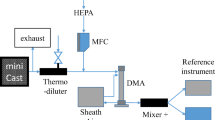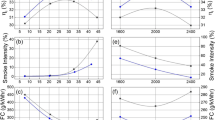Abstract
Gasoline direct-injection (GDI) engines have been reported to produce significantly more particulate matter (PM) mass and particulate number (PN) emissions than do port-fuel-injection (PFI) spark ignition engines. Because smallsized particles are of great concern in terms of their regulation, transmission electron microscopy (TEM) was used to evaluate the sizes of primary and aggregate particles that were thermophoretically collected from three different GDI engines under various engine operating conditions. A low load and retarded fuel injection generally reduced the particle size. Consequently, when the fuel injection timing was delayed at low loads, primary and aggregate particles became extremely small. In particular, a number of nanoparticles were sub-23-nm particles. Careful high-resolution TEM (HRTEM) analyses provided the first evidence that these nanoparticles are solid carbon particles with clear fringe patterns and young soot (and/or highly condensed semi-volatiles) with amorphous carbon patterns. Therefore, this result suggests that the current cut-off size at 23 nm for PN regulation in Euro 6 must be further reduced to include sub-23-nm carbon nanoparticles.
Similar content being viewed by others
References
Aakko, P. and Nylund, N. O. (2003). Particle emissions at moderate and cold temperatures using different fuels. SAE Paper No. 01-3285.
Andersson, J., Giechaskiel, B., Munoz-Bueno, R., Sandbach, E. and Dilara, P. (2007). Particle Measurement Programme (PMP) Light-duty Inter-laboratory Correlation Exercise (ILCE-LD) Final Report. Institute for Environment and Sustainability. EUR 22775 EN.
Andersson, J., Mamakos, A., Giechaskiel, B., Carriero, M. and Martini, G. (2010). Particle Measurement Programme (PMP) Heavy-duty Inter-laboratory Correlation Exercise (ILCE-HD) Final Report. Final Report. Joint Research Center, Ispra (VA). EUR 24561 EN.
Barone, T. L., Storey, J. M., Youngquist, A. D. and Szybist, J. P. (2012). An analysis of direct-injection spark-ignition (DISI) soot morphology. Atmospheric Environment, 49, 268–274.
Braisher, M., Stone, R. and Price, P. (2010). Particle number emissions from a range of European vehicles. SAE Paper No. 01-0786.
CARB (2010). Preliminary Discussion Paper — Proposed Amendments to California’s Low-emission Vehicle Regulations — Particulate Matter Mass, Ultrafine Solid Particle Number, and Black Carbon Emissions. California Air Resources Board, Sacramento, CA. 11 May.
Filippo, A. D. and Maricq, M. M. (2008). Diesel nucleation mode particles: Semi-volatile or solid?. Environmental Science & Technology 42,21, 7957–7962.
Gaddam, C. K. and Vander Wal, R. L. (2012). Physical & chemical characterization of SIDI engine particulates. Combustion and Flame, 160, 2517–2528.
Giechaskiel, B., Chirico, R., DeCarlo, P. F., Clairotte, M., Adam, T., Martini, G., Heringa, M. F., Richter, R., Prevot, A. S. H., Baltensperger, U. and Astorga, C. (2010). Evaluation of the particle measurement programme (PMP) protocol to remove the vehicles’ exhaust aerosol volatile phase. Science of the Total Environment 408,21, 5106–5116.
Jung, H., Zheng, Z., Johnson, K. C., Liu, Z., Durbin, T. D., Kittelson, D. B., Hu, S. and Huai, T. (2011). Measurement of diesel solid nanoparticle emissions using a catalytic stripper for comparison with Europe’s PMP protocol. Directions in Engine-Efficiency and Emissions Research (DEER).
Kittelson, D. B. (1998). Engines and nanoparticles: A review. J. Aerosol Science 29,5, 575–588.
Lahde, T., Ronkko, T., Virtanen, A., Schuck, T. J., Pirjola, L., Hameri, K., Kulmala, M., Arnold, F., Rothe, D. and Keskinen, J. (2009). Heavy duty diesel engine exhaust aerosol particle and ion measurements. Environmental Science & Technology 43,1, 163–168.
Lee, K., Seong, H., Church, W. and McConnell, S. (2012). Examination of particulate emissions from alcohol blended fuel combustion in a GDI engine. The 8 th Int. Symp. Diagnostics and Modeling of Combustion in Internal Combustion Engines (COMODIA). Fukuoka, Japan.
Lee, K., Seong, H., Sakai, S., Hageman, M. and Rothamer, D. (2013). Detailed morphological properties of nanoparticles from gasoline direct injection engine combustion of ethanol blends. SAE Paper No. 24-0185.
Mathis, U., Kaegi, R., Mohr, M. and Zenobi, R. (2004a). TEM analysis of volatile nanoparticles from particle trap equipped diesel and direct-injection spark-ignition vehicles. Atmospheric Environment 38,26, 4347–4355.
Mathis, U., Ristimäki, J., Mohr, M., Keskinen, J., Ntziachristos, L., Samaras, Z. and Mikkanen, P. (2004b). Sampling conditions for the measurement of nucleation mode particles in the exhaust of a diesel vehicle. Aerosol Science and Technology 38,12, 1149–1160.
Myung, C. L. and Park, S. (2012). Exhaust nanoparticle emissions from internal combustion engines: A review. Int. J. Automotive Technology 13,1, 9–22.
Sakai, S., Hageman, M. and Rothamer, D. (2013). Effect of equivalence ratio on the particulate emissions from a spark-ignited, direct-injected gasoline engine. SAE Paper No. 01-1560.
Sakurai, H., Tobias, H. J., Park, K., Zarling, D., Docherty, K. S., Kittelson, D. B., McMurry, P. H. and Ziemann, P. J. (2003). On-line measurements of diesel nanoparticle composition and volatility. Atmospheric Environment 37,9, 1199–1210.
Seong, H., Lee, K. and Choi, S. (2013). Effects of engine operating parameters on morphology of particulates from a gasoline direct injection (GDI) engine. SAE Paper No. 01-2574.
Sgro, L. A., Sementa, P., Vaglieco, B. M., Rusciano, G., D’Anna, A. and Minutolo, P. (2012). Investigating the origin of nuclei particles in GDI engine exhausts. Combustion and Flame 159,4, 1687–1692.
Tree, D. R. and Svensson, K. I. (2007). Soot processes in compression ignition engines. Progress in Energy and Combustion Science 33,3, 272–309.
Zhao, F., Lai, M. C. and Harrington, D. L. (1999). Automotive spark-ignited direct-injection gasoline engines. Progress in Energy and Combustion Science 25,5, 437–562.
Zheng, Z., Johnson, K. C., Liu, Z., Durbin, T. D., Hu, S., Huai, T., Kittelson, D. B. and Jung, H. S. (2012). Investigation of solid particle number measurement: Existence and nature of sub-23nm particles under PMP methodology. J. Aerosol Science 42,12, 883–897.
Author information
Authors and Affiliations
Corresponding author
Rights and permissions
About this article
Cite this article
Seong, H., Choi, S. & Lee, K. Examination of nanoparticles from gasoline direct-injection (GDI) engines using transmission electron microscopy (TEM). Int.J Automot. Technol. 15, 175–181 (2014). https://doi.org/10.1007/s12239-014-0019-5
Received:
Revised:
Accepted:
Published:
Issue Date:
DOI: https://doi.org/10.1007/s12239-014-0019-5




